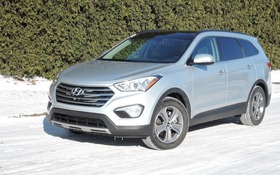2015 Hyundai Santa Fe: Balance From Top To Bottom

| Strong points |
|
|---|---|
| Weak points |
|
When Korean manufacturer Hyundai unveiled the first-generation Santa Fe in 2001, the vehicle was characterized by a cartoonish albeit nice silhouette and a very competitive price. Sure, there was available all-wheel drive, but it was totally inefficient. But with each new model year, the product has continually improved to the point that today the Santa Fe is considered one of the best in its class.
It’s important to note that Hyundai’s SUV line-up includes three models. The Tucson is the most affordable and compact. It targets clients in the market for an interesting product at a good price. Next, there’s the Santa Fe Sport. With a 2,700 mm wheelbase, it’s able to seat five passengers. Finally, there’s the XL, which has a longer wheelbase (2,800 mm) and can accommodate up to six or seven passengers depending on whether the second row is made up of a bench or captain’s chairs. This version is powered by a V6 engine.
- Also: 2015 Hyundai Santa Fe XL: A Test Drive In My (Snowy) Backyard
- Also: Nearly 650,000 Hyundai and Kia Vehicles Recalled Due to Fire Hazard
The XL is, in fact, a more economical, pared down descendant of the defunct Veracruz, a luxury SUV that indirectly targeted the Lexus RX350. It seemed to have bitten off more than it could chew, however, at least at the time, and the project was scrapped. Despite this, don’t take that to mean that the Santa Fe XL that pretty much takes its place in the Hyundai line-up is not a quality vehicle.
Not just longer
At first glance, you’d think that all Hyundai did was extend the body and wheelbase and make the vehicle a tad wider and a little higher than the Santa Fe Sport. However, to differentiate the two vehicles from a visual standpoint and balance the lines considering the sheer size of the vehicle, the side panels have been modified. The result – while not exactly a groundbreaking design – is nice, and perhaps even stylish, if I do say so myself.
Personally, I don’t find the manufacturer’s logo particularly elegant, and the exterior appearance would benefit from a more imaginative insignia. It may seem like a minor detail, but I am convinced that this impacts the visual impact of the vehicle.
In the passenger compartment as with the exterior, there’s nothing too spectacular or too bold. On the other hand, the stylists respected current trends and at the centre of the dashboard there’s a vertical console housing a very small display screen framed by easy-to-access controls. Note that our test vehicle didn’t have a navigation system. In the lower part, the climate controls include such features as a small screen that displays air direction, blower speed and temperature selected.
The materials are good quality and the dashboard covering is supple. The steering wheel, leather-covered in several versions, is heated and comfortable. On the right horizontal spoke you’ll find the cruise control buttons along with one that regulates the power steering. The three available driving modes are Comfort, Normal and Sport. There’s a noticeable difference between each and although most people with use the Normal setting, Sport mode is the most interesting. The controls for the sound system are located on the left spoke.
The driving position is flawless and the power adjustable seats are comfortable. The back seats, captain’s chairs in our test vehicle, are cozy, though their lateral support could have been better. However, as is the case for all vehicles with a third row of seats, they’re hard to access. What’s convenient is that there are dedicated controls for the rear passengers to adjust the blower and the heat themselves. Finally, it has a power liftgate and a gigantic panoramic sunroof.
Adapted mechanics
There are no surprises or innovations under the XL’s hood. You’ll find a 3.3-litre V6 engine producing 290 horsepower and 252 lbs.-ft. of torque paired with a very game six-speed automatic transmission. The most economical version is equipped with front-wheel drive, but it would be ill advised not to go for the optional all-wheel drive: it may not be as sophisticated as those offered by certain European competitors sold at a much higher price, but it’s efficient.
The rear suspension is independent and the total weight of this vehicle is relatively low despite its size, thanks to the use of quality steel that helps ensure lightness and rigidity.
Predictable
The ride is a direct reflection of the silhouette and passenger compartment presentation: it’s slightly better than average with good acceleration and handling that lets you take on turn after turn without any surprises. It behaves not unlike a large sedan with a comfortable suspension and is neutral in turns. However, rear visibility isn’t this Hyundai’s forte and we appreciated the factory-standard back-up camera, but don’t forget that the display screen is rather small.
A blind spot detection system is always practical in city traffic and the Santa Fe XL’s does a good job, even though it sometimes warned us of the presence of a vehicle that was reasonably far away. Moreover, the warning sound is not only annoying but extremely loud.
At the end of the day, these are just minor details. Overall, it’s a balanced SUV with a meticulous finish and a good warranty.











